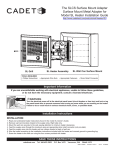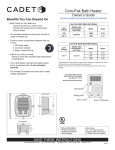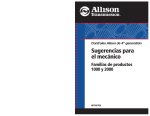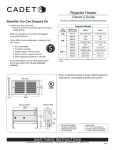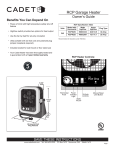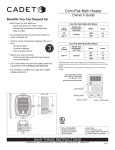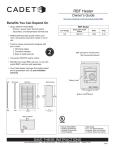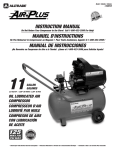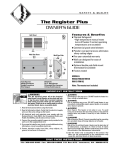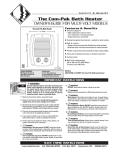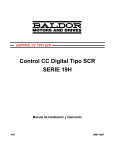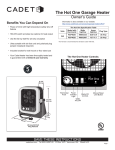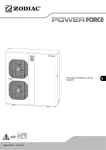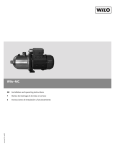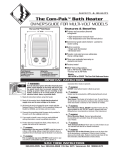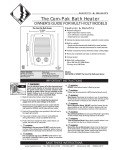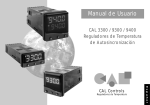Download Energy Plus Heater - Northern Tool + Equipment
Transcript
Energy Plus Heater Benefits You Can Depend On • Sensible and energy efficient, use up to 30% less energy • Brings you only the heat you need, when you need it, and adjusts automatically to save you money Owner’s Guide http://www.cadetheat.com/products/wall-heaters/energy-plus Energy Plus Models Line Voltage 208 240 500 4.2 750 3.6 800 3.3 1000 8.3 1500 7.2 1600 6.7 (1) 208 240 CE163T (1) (1) 240 volt models can be used at 208 volts. Wattage equals 75% of 240v rated wattage. Night/Away and Max/Min options for extra savings and safety Energy Plus Model With Built-In Controller *Wall Thermostat Not Required Improve air circulation, add comfort in off-season with three fan speeds Before pushing RESET button see Owner’s Guide for display fault 3108579 codes and other conforms troubleshooting to UL STD information. 2021 Disconnect power at circuit breaker before servicing. Do not operate without grill. WARNING! TO AVOID ELECTRICAL SHOCK Model: Volts: Watts: cadetheat.com Vancouver, WA Mfg Date: Easily replaces many Com-Pak Series heaters: C, CB, CM, CS, FX or X • Installs in 3 easy steps and power supply sensor eliminates guesswork 072xxx Rating Label • Common sense components designed with you in mind: Peace of mind safety with automatic high temperature shutoff Amps CE083T 120 • Our newest and most thoughtful design features: Easy, intuitive one-touch controls Watts 120 • You define your comfort—maintains your room temperature within one degree Large, digital display shows your room temperature and heating mode Model with Built-In Controller NO F NO HEAT Controller with Digital Display and Push Buttons NO sharp edges Corrosion resistant Side Grill Front Wall Can Side Our sturdiest element provides cozy warmth for years of reliable use • Your Energy Plus heater has been thoroughly tested and is guaranteed with a 5 year extended warranty 12” 30.48 + 10” 25.4 111/8” 28.26 NO F 3¼” 8.26 NO HEAT COM-PAK NO FAN NO HEAT SLEEP FAN ONLY 5 /8” 1.6 1¼” 3.18 HEAT 9” 22.86 Wall Can Bottom 7 7/8” 20.00 PATENT PENDING TOOLS REQUIRED: • Phillips Screwdriver • Straight Screwdriver • Wire Strippers • Utility Knife • (4) 1 1/2“ Wood Screws • Insulated Wire Connectors • (1) Strain Relief Connector 3” 7.62 1¾” 4.45 4” 10.16 conforms to UL Std 2021 1¼” 3.18 SAVE THESE INSTRUCTIONS cadetheat.com Tel: 360-693-2505 PO Box 1675 Vancouver, WA 98668-1675 Page 1 IMPORTANT INSTRUCTIONS WARNING When using electrical appliances, basic precautions should always be followed to reduce the risk of fire, electric shock, and injury to persons, including the following: 1. Read all instructions before installing or using 7. WARNING this heater. Risk of Electrical Shock. Do not insert or allow foreign objects to enter any ventilation or exhaust 2. WARNING opening as this may cause an electric shock or Risk of Fire. This heater is hot when in use. fire, or damage the heater. Caution—High Temperature. Risk of Fire. Keep electrical cords, drapery, furnishings, and other 8. WARNING combustibles at least 3 feet from the front of the Risk of Fire. To prevent a possible fire, do not heater and 6 inches above and on both sides. block air intakes or exhaust in any manner. 3. WARNING 9. WARNING Burn Hazard. To avoid burns, do not let bare skin Fire or explosion may occur. A heater has hot and touch hot surfaces. Extreme caution is necessary arcing or sparking parts inside. Do not use it in when any heater is used by or near children or areas where gasoline, paint, or flammable vapors invalids and whenever the heater is left operating or liquids are used or stored. and unattended. 10. Use this heater only as described in this 4. WARNING manual. Any other use not recommended by the Risk of Electrical Shock. Do not operate any manufacturer may cause fire, electrical shock, or heater after it malfunctions. Disconnect power injury to persons. at service panel and have heater inspected by a 11. The heater must be properly installed before qualified electrician before reusing. it is used. 5. WARNING 12. WARNING Do not use outdoors. Risk of Electrical Shock and Fire. Do not operate 6. To disconnect heater, turn controls to off, and without grill. turn off power to heater circuit at main disconnect 13. Save these instructions. panel. Wiring Diagram WHITE HEATING ELEMENT 1 2 CONNECTOR RED 240 VOLT KEY 3 4 BLACK 1 2 BLACK 120 VOLT KEY BLACK 3 4 MANUAL RESET HIGH TEMPERATURE LIMIT 1 2 MOTOR THERMOSTAT CONTROL 3 4 THERMISTOR RED WHITE WHITE YELLOW BLACK YELLOW L1 BROWN L2 or N MODE SWITCH ORANGE SAVE THESE INSTRUCTIONS Page 2 cadetheat.com Tel: 360-693-2505 PO Box 1675 Vancouver, WA 98668-1675 Before you begin, you should know... ...about the Cadet Energy Plus heater The Cadet Energy Plus Heater provides zonal heat to a room by using an efficient, variable speed fan to circulate the warm air, and an intelligent thermostat to deliver precise temperature control. The Cadet Energy Plus heater is designed to save energy and run at a low speed and heat output once the desired room temperature is reached. This is normal operation for maintaining and regulating desired room temperature. This low speed fan movement also provides better air mixing within the room, and fewer on/off cycles. Safety is Cadet’s first priority. All CE-Series heaters feature an oversized high temperature limit switch that shuts the heater off when excessive operating temperatures are detected. For effective and safe operation, and to prolong the life of the heater, read all instructions and safety information, and follow the maintenance instructions in this Owner’s Guide. + NO F NO HEAT A NO FAN NO HEAT SLEEP FAN ONLY HEAT ...some general tips NO SLEEP NO HEAT A + F FAN ONLY NO FAN NO HEAT HEAT • The heater has a cool down feature that will run the fan for up to 10 minutes after switching to NO HEAT mode or if set point is reached and mild outdoor temperatures create low demand. This is normal. The air being discharged may feel cool, but is actually room temperature residual heat moving into the room. • Because the digital thermostat is onboard the Energy Plus Heater, it is very important to conduct proper maintenance (See Page 8) of the heater to maintain peak performance and safety. • The Cadet Energy Plus heater’s unique variable speed blower will auto adjust, based on the room requirements and heat output. It may quietly deliver heat at a low speed, for optimum performance and energy savings once desired temperature setpoint is reached. ...some installation facts • For new installation, you should be prepared to run wire or electrical conduit to your desired location for your heater. • A qualified or dedicated circuit from circuit breaker panel is required. • An in-wall electric fan heater is a permanent, safe, hard wired solution that requires a cut out in your wall to recess the heater, unless a Cadet surface mount adapter is used. • The Cadet Energy Plus heater must only be installed vertically in a wall. • The heater must not be installed in the floor or ceiling, even if you are replacing an existing heater that was installed in either of these locations. • Installation on an inside wall is recommended. • For better comfort, do not install where air is likely to continuously blow directly onto you or another person. • The recommended height from the floor is 12 inches for easy access to the digital thermostat. It will function properly in lower positions, but must not be lower than 4½ inches above the floor. • If you are replacing a heater, the Cadet Energy Plus heater must only be installed with a Com-Pak style wall can model FXC/XC/CC. Check the label in the existing wall can to make sure this is the type you are replacing. + NO F NO HEAT A NO FAN NO HEAT SLEEP FAN ONLY HEAT • Be sure that your existing or new wall can is mounted flush with the outside of the sheetrock. ...that a wall thermostat is not required A wall thermostat may not be used to control this heater. The Energy Plus heater is equipped with a unique onboard thermostat that both regulates the heater output and provides precise temperature control. If replacing a heater controlled by an existing wall thermostat, remove wall thermostat from the heater circuit and cover hole with a faceplate. Black wires To breaker To heater Remove thermostat TO REMOVE AN EXISTING WALL THERMOSTAT FROM HEATER CIRCUIT 1. Make sure power is off at the circuit breaker. 2. Remove wall thermostat mounting screws. 3. Pull the thermostat away from the wall and count the wires. 4. A. If you count 2 black supply wires and 2 white supply wires in the box, disconnect thermostat and connect the 2 black wires together with one connector. Connect the 2 white wires together with another connector. Connect all ground wires together. B. If you have 1 black supply wire and 1 white supply wire, disconnect thermostat and Junction connect the black and white wires together with a connector. Connect all ground wires box cover together. (not included) C. If you have more than 2 black or 2 white wires, please consult a qualified electrician. 5. If you have a metal junction box, it must be grounded. (Use a grounding screw or clip.) 6. Install a blank faceplate (not provided) over the exposed junction box. White wires All ground wires Page 3 INSTALLATION INSTRUCTIONS 1. WARNING Verify that the electrical supply wires are the same voltage as the heater. 2. If replacing an existing heater, check the label of the old heater. 3. All electrical work and materials must comply with the National Electric Code (NEC), the Occupational Safety and Health Act (OSHA), and all state and local codes. 4. If you need to install a new circuit or need additional wiring information, consult a qualified electrician. 5. Use copper conductors only. 6. WARNING Risk of Electrical Shock. DO NOT install the heater directly above bathtub or sink. DO NOT install in shower stall area (Manufacturer recommends a minimum 2 foot clearance). 7. Heater must be installed in a wall can: Model CE Wall Can CC __________________________ Part 8. WARNING Risk of Fire. DO NOT install the heater in a floor, in the ceiling, below a towel bar, behind a door, or anywhere the air discharge may be blocked in any manner. 9. WARNING Fire or Explosion May Occur. A heater has hot and arcing or sparking parts inside. Do not use it in areas where gasoline, paint, or flammable vapors or liquids are used or stored. 10. WARNING Risk of Electrical Shock. Connect grounding lead to grounding screw provided. Keep all foreign objects out of heater. 11. WARNING Risk of Fire. This heater is hot when in use. Caution—High Temperature. Risk of Fire. Keep electrical cords, drapery, furnishings, and other combustibles at least 3 feet from the front of the heater and 6 inches above and on both sides. One __________________________ REPLACEMENT: If you are replacing an existing Com-Pak Model, proceed to PART TWO, page 5. Confirm that your existing wall can is mounted flush with outside of sheetrock. Adjust if necessary. PLACEMENT: Install vertically. Heater is not approved for horizontal or ceiling mount applications. CONTROLS: A built-in digital thermostat is included. May not be used with a wall thermostat. How do I install for new construction? STEP 1 Mount The Wall Can REQUIRED MINIMUM distance of 6 inches from adjacent surfaces and 4-1/2 inches from the floor (See Figure 4). However, Cadet RECOMMENDS 12 inches from adjacent surfaces and floor for longer and cleaner performance. Heaters must be spaced at least 3 feet apart. Secure the wall can to the stud with 2 screws (See Figures 1 & 2). As an option, the rubber shim provided may be attached to side of wall can to square the wall can to the stud. Figure 1 Face of wall can must extend 1/2 inch or 5/8 inch from face of stud to allow for thickness of sheetrock. How do I install in an existing wall? STEP 1 Cut A Hole In The Wall REQUIRED MINIMUM distance of 6 inches from adjacent surfaces and 4-1/2 inches from the floor (See Figure 4). However, Cadet RECOMMENDS 12 inches from adjacent surfaces and floor for longer and cleaner performance. Heaters must be spaced at least 3 feet apart. Cut a hole 8 inches wide by 10-1/4 inches high next to a wall stud. STEP 2 Route Supply Wires Route supply wire from the circuit breaker, to the heater. Remove a knockout from the wall can and attach the supply wire with a strain relief connector (not included) leaving a minimum of 6 inches wire lead for later use. Connect supply ground wire to grounding screw in wall can (See Figure 3). SUPPLY WIRE KNOCK-OUT (TWIST TO REMOVE) STRAIN RELIEF CONNECTOR GROUNDING SCREW Figure 3 Figure 2 Attach wall can to stud with screws through holes provided in wall can. IMPORTANT: wall can should be mounted flush with outside of sheetrock. Figure 4 STEP 2 Route Supply Wires Route supply wire from the circuit breaker, to the heater. Remove a knockout from the wall can and attach the supply wire with a strain relief connector (not included) leaving a minimum of 6 inches wire lead for later use. Connect supply ground wire to grounding screw in wall can (See Figure 3). Proceed to PART TWO. Page 4 STEP 3 Mount The Wall Can Insert wall can into opening; keeping wall can flush with wall surface. Secure can to wall stud with 2 screws through holes provided in can. IMPORTANT: wall can should be mounted flush with ouside of sheetrock. Proceed to PART TWO. INSTALLATION INSTRUCTIONS (continued) __________________________ __________________________ Part Two STEP 1 Determine Supply Voltage A qualified or dedicated circuit from circuit breaker panel is required. Before operating, verify that the heater is configured for correct supply voltage and circuit load. The Energy Plus heater is configured for 240-Volt operation by default. For 120-Volt installation, you must switch the supplied “keys” (see Step 2) to easily configure the heater to the same voltage as the supply wires. The volt sensor can assist you in confirming correct installation, after installing the heater assembly (Step 3). Don’t worry: if you install incorrectly, you can safely reconfigure the heater using the Fault Code Chart on page 7 without damaging the heater. STEP 2 Select Proper Heater Voltage For 240-Volt configuration: The Energy Plus Heater is factory configured for 240-Volt operation with a “black key” (Figure 5). Proceed to STEP 3. CORRECT 240 VOLT CONFIGURATION (DEFAULT) For 120-Volt configuration: Remove the supplied “black key” (FIGURE 6) located on the side of the heater. Replace with the provided “white key” as shown in Figure 7. REMOVE KEY CORRECT 120 VOLT CONFIGURATION Black Wire Key White Wire Key Figure 6 Figure 5 Figure 7 How do I insert the heater assembly into the wall can? STEP 3 Install Heater Assembly Turn heater assembly so that the front of it is facing the floor (element down with motor facing you). You can then rest bottom edge of the heater assembly on the bottom of the wall can while supporting the edge closest to you. (See Figure 8). Connect the supply wires to the heater wires with connectors (See Figure 9 or Figure 9a). Now rotate heater assembly into wall can so that the bottom edge drops into the half round slots in bottom lip of wall can (See Figure 10). IMPORTANT: Push wires into bottom and left side of wall can during insertion. Be sure supply wires are not caught between motor and wall can. After confirming that the bottom edge of heater is positioned in the slots in bottom lip of wall can, attach assembly at top with screw provided. STEP 4 Install Grill Align push buttons and digital display with grill cutouts before tightening with grill screws provided. Do not overtighten (See Figure 11). STEP 5 Confirm your Supply Voltage and Proper Installation Turn electrical power back on at the circuit breaker or fuse box. WAIT 10-15 seconds for heater to power-up before pushing any buttons. The Energy Plus heater is equipped with a smart sensor that will indicate if the voltage does not match your key configuration. Review the digital display to confirm if you have configured the heater to match the supply voltage. The heater will not operate if it is not configured correctly. If the heater has been configured to the correct circuit: Display backlight will come on and read “88” for a moment; then will display actual temperature if in NO HEAT mode; flash the temperature set point if in HEAT mode; or 1,2,3 if in FAN ONLY mode. After 10 seconds, room temperature will be displayed. Proceed to OPERATING YOUR HEATER. If the heater has been configured to the incorrect circuit or improperly installed, a code will display. See Fault Codes, page 7. Wiring to Other Heater Field Wiring to Breaker Figure 8 Figure 9 (Single Heater 120/208/240V) Figure 9a (Multiple Heaters on a branch circuit, 208 or 240V ONLY) Figure 10 Figure 11 Page 5 OPERATING INSTRUCTIONS WARNING Risk of Electrical Shock and Fire. The heater must be properly installed before it is used. 1. Do not operate without grill. 2. Keep electrical cords, drapery, furnishings and other combustibles at least 3 feet away from the front of the heater and 6 inches away from the sides. 3. Do not tamper with the over temperature limit control. 4. If the heater over temperature limits trip more than once per day, the heater must be replaced. Digital Display Fan Operation Fahrenheit Setting Temperature Night/Away Mode Icon Proportional Heat Control Indicator Heating Mode Indicator Heater Modes Using the rocker switch, you can move the switch to three modes. NO FAN NO HEAT + NO F NO HEAT A Down Button Night Button NO FAN NO FAN NONO HEAT HEAT NIGHT / SLEEP AWAY Rocker Switch FAN HEAT ONLY FAN ONLY HEAT Setting Desired Heating Temperature Up • Turn rocker switch to HEAT mode. • Touch the up button or the down button to set your desired temperature. Down Temperature Setpoint Range: 40˚F - 90˚F Programming Your Night/Away Button FAN ONLY Rocker Switch CENTER POSITION: NO HEAT MODE After a brief cool down period (up to 4 minutes), the heater will shut down. It will not resume heating until the rocker switch is flipped to the HEATING (left) position. fan is animated No Heat, Cool Down LEFT POSITION: HEAT MODE No Heat Your ComPak Energy Plus heater has a unique variable speed blower that auto adjusts the heat output based on the room’s requirements. Once you set the thermostat to your desired temperature, the heater will vary the wattage output for maximum efficiency. The digital display will show the level of heat being output to maintain the room’s temperature. Heating Full Power Heating Mid Power RIGHT POSITION: FAN ONLY MODE Heating Low Power The FAN ONLY mode can circulate air but will not supply heat. Three fan speeds are available. To adjust the fan speed: With rocker switch in the RIGHT position, push top (+) or bottom (-) digital buttons up or down. Display will read “1” for low speed, “2” for medium speed, or “3” for high speed during the set up process, then resume to temperature display. Page 6 Control Buttons Up Button Digital Display Fan Mode Indicator HEAT 5. Clean heater at least every six months. 6. After allowing the heater to cool, turn power off at circuit breaker panel before removing grill. 7. Use a hair dryer or vacuum on blow cycle to blow debris through the top element (do not touch element). 8. Install the grill before turning on power. WARNING: Any other service not detailed in this Owner’s Guide should be performed by an authorized service representative. Fan Only / No Heat You can preset a night or away temperature set point, for quick and easy “one-touch” energy savings. • Turn rocker switch to HEAT mode. • Push Night button to activate. The moon icon will show in display screen. The “night/ away” setpoint temperature will flash for 5 seconds. • Push the Up or Down button to change your desired night/away set point. • To return to your previous HEAT set point when you awake or return, push the Night again. The setpoint temperature will flash for 5 seconds. The moon icon will no longer be in display screen. • To return to your previous night/away setpoint, simply push the Night button. NIGHT / AWAY Night/Away Button Night/Away Mode Max/Min Temperature Lock You can preset a maximum and/or minimum set point as a child safety or tamper proof option. To preset a maximum setpoint: • Move rocker switch to NO HEAT mode. • Press and hold both the Night button and the Up button at the same time, for at least 5 seconds, until the “HL” (high limit) is displayed. • Release buttons: temperature setpoint will flash and alternate with “HL” on the display. • Using the Up or Down button, set your maximum desired set point. • Turn rocker switch back to HEAT mode. • To remove the lock, follow same instructions, and set to maximum of 90 degrees. • To preset a minimum set point, follow same steps, but press and hold both the Night and Down buttons until the “LL” (low limit) is displayed. Energy Saving Tips • Set your Night/Away set point to as low as you are comfortable, for a cooler nighttime temperature. • When you exit the room or leave your home, push the Night button to drop the temperature set point. • If your heater is positioned in a drafty area or exposed to direct sunlight, temperature reading will be affected. Set temperature to desired comfort level, not a “number” on the digital display. • If you will be away for an extended period of time (and have no concerns about freezing conditions), turn the rocker switch to NO HEAT for even greater energy savings. OPERATING INSTRUCTIONS (continued) Digital Display Reads No Display Problem Fault Codes Solution No power, internal fuse Check that power is being supplied to heater; if operating on generator power, blown, internal control faulty make sure line frequency is correct; if display still doesn’t turn on then control is defective and heater assembly must be replaced. F1 Grill is interfering with buttons Turn power off at circuit breaker, realign grill so buttons can push freely. Turn power back on at circuit breaker. F2 Wrong voltage selector key Turn power off at the circuit breaker, remove 120V white key, install 240V black key, turn power back on at circuit breaker. F3 Wrong voltage selector key Turn power off at the circuit breaker, remove 240V black key, install 120V white key, turn power back on at circuit breaker. F4 1. Line voltage is too low 2. Loose wire connections, or black/white key is not fully engaged 1. Clears automatically when line voltage returns to normal. 2. Check wire connections and that black or white key is securely in place. F6 Line voltage is too high Clears automatically when line voltage returns to normal. F7 Thermal limit (temperature limiting control) tripped Inspect heater for blockage, obstruction, and/or proper clearance. Move rocker switch to center (NO HEAT) position and wait for heater to cool. Push manual reset limit button per the MAINTAINING YOUR HEATER instructions (Page 8). F8 Internal control fault Disconnect power, reconnect power. If F8 code returns, control is faulty. Replace heater assembly. 12 No voltage selector key installed Turn power off at the circuit breaker, install 120V white key, turn power back on at circuit breaker. 24 No voltage selector key installed Turn power off at the circuit breaker, install 240V black key, turn power back on at circuit breaker. About the Manual Reset Temperature Limit Control The heater is protected by a temperature-limiting control. The manual reset temperature limit control is designed to open the heater circuit when excessive operating temperatures are detected. The problem must be assessed (typically the heater is blocked or needs cleaning) and the limit must be reset to resume operation. Resetting the Manual Reset Limit Control Before pushing RESET button see Owner’s Guide for display fault 3108579 codes and other conforms troubleshooting to UL STD information. 2021 Disconnect power at circuit breaker before servicing. Do not operate without grill. 072xxx Manual Reset Limit Button WARNING! TO AVOID ELECTRICAL SHOCK Model: Volts: Watts: If the manual reset limit control has opened the heater circuit due to excessive operating temperatures, the heater will not work until the manual reset limit button is pressed. The “manual reset limit button” is the red button located on the upper left side of your heater, behind the grill louvers located just above the digital temperature display. After allowing the unit to cool for at least 10 minutes and resolving the problem causing the limit to trip (typically the heater is blocked or needs cleaning); use a narrow object such as a ball-point pen to access the manual reset button through the upper-left center section of the heater grill. Press FIRMLY and be sure to listen and feel for a click, indicating it has been reset. cadetheat.com Vancouver, WA Mfg Date: Resetting the Manual Reset Temperature Limit Control NO F NO HEAT Warranty For more effective and safer operation and to prolong the life of the heater, read the Owner’s Guide and follow the maintenance instructions. Failure to properly maintain the heater will void any warranty and may cause the heater to function improperly. Warranties are non transferable and apply to original consumer only. Warranty terms are set out below. LIMITED FIVE-YEAR WARRANTY: Cadet will repair or replace any Energy Plus (CE) heater found to be defective within five years after the date of purchase. These warranties do not apply: 1. Damage occurs to the product through improper installation or incorrect supply voltage; 2. Damage occurs to the product through improper maintenance, misuse, abuse, accident, or alteration; 3. The product is serviced by anyone other than Cadet; 4. If the date of manufacture of the product cannot be determined; 5. If the product is damaged during shipping through no fault of Cadet. 6. CADET’S WARRANTY IS LIMITED TO REPAIR OR REPLACEMENT AS SET OUT HEREIN. CADET SHALL NOT BE LIABLE FOR DAMAGES SUCH AS PROPERTY DAMAGE OR FOR CONSEQUENTIAL DAMAGES AND/OR INCIDENTAL EXPENSES RESULTING FROM BREACH OF THESE WRITTEN WARRANTIES OR ANY EXPRESS OR IMPLIED WARRANTY. 7. IN THE EVENT CADET ELECTS TO REPLACE ANY PART OF YOUR CADET PRODUCT, THE REPLACEMENT PARTS ARE SUBJECT TO THE SAME WARRANTIES AS THE PRODUCT. THE INSTALLATION OF REPLACEMENT PARTS DOES NOT MODIFY OR EXTEND THE UNDERLYING WARRANTIES. REPLACEMENT OR REPAIR OF ANY CADET PRODUCT OR PART DOES NOT CREATE ANY NEW WARRANTIES. 8. These warranties give you specific legal rights, and you may also have other rights which vary from state to state. Cadet neither assumes, nor authorizes anyone to assume for it, any other obligation or liability in connection with its products other than as set out herein. If you believe your Cadet product is defective, please contact Cadet Manufacturing Co. at 360-693-2505, during the warranty period, for instructions on how to have the repair or replacement processed. Warranty claims made after the warranty period has expired will be denied. Products returned without authorization will be refused. Parts and Service Visit cadetheat.com/parts-service for information on where to obtain parts and service. Reduce-Reuse-Recycle This product is made primarily of recyclable materials. You can reduce your carbon footprint by recycling this product at the end of its useful life. Contact your local recycling support center for further recycling instructions. Page 7 MAINTAINING YOUR HEATER Maintenance As Needed, or every six months minimum. WARNING! Before removing grill, turn the electrical power off at the electrical panel board (circuit breaker or fuse box). Lock or tag the panel board door to prevent someone from accidentally turning the power on while you are working on the heater. Failure to do so could result in serious electrical shock, burns, or possible death. WARNING: Any other service not detailed in this Owner’s Guide should be performed by an authorized service representative. 1. It is important that you verify power has been turned off and no power is going to the heater before proceeding. Circuit breakers are often not marked correctly and turning the wrong breaker off could mean electricity is flowing to the heater, even if the heater does not appear to be working. If you are uncomfortable working with electrical appliances, unable to follow these guidelines, or do not have the necessary equipment, consult a qualified electrician. 2. Once you verify the power has been turned off correctly, proceed to the next step. 3. Remove screws and take off grill. 4. Wash grill with hot soapy water and dry immediately. 5. While holding fan (to avoid damage or bending), use a hair dryer or vacuum on blow cycle to blow debris through the top element (do not touch element). 6. Vacuum fan area without touching the elements. 7. Do not lubricate motor. 8. Replace grill and secure with screws. 9. Turn thermostat to desired setting. 10. Turn power back on at the electrical panel board. Troubleshooting Chart *CONSULT LOCAL ELECTRICAL CODES TO DETERMINE WHAT WORK MUST BE PERFORMED BY QUALIFIED ELECTRICAL SERVICE PERSONNEL. Symptom Heater is working, but room does not reach desired temperature. Problem 1. Heat loss from room is greater than heater capacity.* 2. Furniture or other surfaces may be too close to the heater. 3. Verify if temperature lock has been set. Thermostat setpoint is 40-90 degrees. Breaker trips immediately upon energizing heater. 1. Overloaded circuit.* Solution 1. Close doors and windows. Provide additional insulation, or install a higher wattage heater or multiple heaters if necessary. (If your circuit is rated for more capacity.) 2. Remove furniture or other surfaces to appropriate clearances, so air can flow freely throughout room. Maintain a minimum distance of 6 inches from adjacent surfaces, 4.5 inches from the floor, and 3 feet from furniture or other objects placed directly in front of the heater. 3. See “Maximum Temperature Lock” on page 6. 3. Defective circuit breaker.* 4. Thermostat malfunction. 1. The total amperage of all heaters on a branch circuit must not be more than 80% of the amperage rating of the circuit breaker and supply wire ratings. Use a lower wattage heater, or reduce the number of heaters on the circuit. 2. Shorted supply or heater wires may be accompanied by severe sparking. Inspect all supply and heater wiring insulation for damage. Do not reset the circuit breaker until all electrical shorts have been repaired. 3. Replace the circuit breaker. 4. Replace heater assembly. Heater fan operates, but does not discharge warm air. 1. Rocker switch is not set to HEAT mode. 2. Element has failed.* 1. Turn rocker switch to HEAT mode. 2. Replace element. Heater will not shut off. 1. Heater continues to run at low speed. 1. If room temperature is being regulated and maintained, a low fan speed and low heat output is normal for this energy saving heater. 2. Close doors and windows. Provide additional insulation, or install a higher wattage heater or multiple heaters if necessary. (If your circuit is rated for more capacity.) 3. Replace heater assembly. 2. A short circuit exists in the supply or heater wiring.* 2. Heat loss from room is greater than heater capacity.* 3. Thermostat is not functioning properly. Heater discharges smoke or emits a burnt odor. 1. Dust, lint or other matter has accumulated inside heater. 2. Poor or loose electrical connections. 1. Clean heater (See “Maintaining Your Heater” section for instructions). Element heats for a moment without the fan turning, then immediately stops heating. 1. Defective motor or internal connection.* 2. Fan is jammed. 1. Heater or fan motor requires replacement. 2. Remove obstruction and confirm that fan is spinning freely. Press reset button per the “Maintaining Your Heater” section. Heater does not run. 1. Thermostat is set too low. 1. Adjust thermostat to a higher temperature until heater operates (See Problem #6 if the problem persists). 2. Switch rocker switch to “HEAT” mode. 3. Press the manual reset button (See “Maintaining Your Heater” section for instructions). 4. Turn on the correct circuit breaker in the main panel. 5. Turn off power at circuit breaker. Check supply wire continuity and proper connection to heater wires. 6. Repair or replace the heater assembly. 7. Correct the circuit breaker installation. Heater continually trips the manual reset temperature limit control. 1. Dust, lint or other matter has accumulated inside heater. 2. Airflow is blocked. 2. Rocker switch is set to “NO HEAT”. 3. Heater has tripped the manual high-temperature reset switch. 4. Power not on at the circuit breaker. 5. Broken or poorly connected wire(s) to heater. 6. Defective thermostat. 7. Circuit breaker not installed correctly. 3. Fan or motor is jammed. 4. None of the above. Page 8 2.Turn off power at circuit breaker. Inspect all supply and heater wires for loose or poor connections. Secure or reconnect all loose connections. Do not reset circuit breaker until all connections have been checked or repaired. 1. Clean heater (See “Maintaining Your Heater” section for instructions). 2. Remove obstruction. Maintain a minimum distance of 6 inches from adjacent surfaces, 4.5 inches from the floor, and 3 feet from furniture or other objects placed directly in front of the heater. 3. Remove obstruction, and press heater manual reset button (See “Maintaining Your Heater” section for instructions). 4. Replace heater assembly. ©2014 Cadet Printed in USA Rev 07/14 #720055 El Calentador Energy Plus Guía Para el Propietario Beneficios En Las Que Puede Confiar • Sensible y económico, consume hasta el 30% menos energía http://www.cadetheat.com/products/wall-heaters/energy-plus Energy Plus Modelos Voltaje Línea • Le entrega sólo el calor que necesita, cuando usted lo requiera, y se ajusta automáticamente para ahorrarle dinero Modelo con Controlador Incorporado Vatios Amps 500 4.2 750 3.6 800 3.3 1000 8.3 1500 7.2 1600 6.7 120 208 • Usted define su comodidad—mantiene la temperatura ambiente con un margen de un grado CE083T 240 (1) 120 • Nuestro diseño más reciente y creativo incluye: 208 Gran pantalla digital en la que aparece la temperatura ambiente y el modo de calentamiento Controles sencillos e intuitivos con un solo toque Las opciones de Noche/Ausencia y Máx/Mín aportan más ahorro y seguridad Mejora la circulación del aire, brinda mayor comodidad fuera de la temporada fría con un ventilador de tres velocidades Reemplaza fácilmente muchos calentadores de la serie Com-Pak: C, CB, CM, CS, FX o X 240 CE163T (1) (1) Los modelos de 240 voltios pueden usarse a 208 voltios. El vatiaje es igual al 75% de la potencia nominal de 240 v. Modelo Energy Plus con Controlador *No requieren termostato mural Before pushing RESET button see Owner’s Guide for display fault 3108579 codes and other conforms troubleshooting to UL STD information. 2021 Disconnect power at circuit breaker before servicing. Do not operate without grill. WARNING! TO AVOID ELECTRICAL SHOCK Model: Volts: Watts: cadetheat.com Vancouver, WA Mfg Date: 072xxx • Se instala en 3 sencillos pasos y el sensor del suministro de alimentación evita las suposiciones Etiqueta Calificación NO F NO HEAT • Componentes con sentido común diseñados pensando en usted Controlador con Pantalla Digital y Botones Tranquilidad y seguridad gracias al corte automático por alta temperatura SIN bordes filosos Resistentes a la corrosión Nuestro elemento de máxima resistencia brinda una agradable calidez durante muchos años de uso confiable Costado Rejilla Frente • Su calentador Energy Plus ha sido completamente probado y cuenta con una garantía extendida de 5 años Cámara de pared costado 12” 30.48 + 10” 25.4 111/8” 28.26 NO F 3¼” 8.26 NO HEAT NO FAN NO HEAT SLEEP COM-PAK FAN ONLY 5 /8” 1.6 1¼” 3.18 HEAT 9” 22.86 Cámara de pared inferior 7 7/8” 20.00 PATENTE PENDIENTE HERRAMIENTAS NECESARIAS: • Destornillador Phillips • Destornillador plano • Pelacables • Cuchillo multiuso • (4) tornillos de 1½” para madera • Conectores de alambre aislados • (1) conector de alivio de tensión 3” 7.62 1¾” 4.45 4” 10.16 1¼” 3.18 cumple con la norma UL 2021 CONSERVE ESTAS INSTRUCCIONES cadetheat.com Tel: 360-693-2505 PO Box 1675 Vancouver, WA 98668-1675 Página 9 INSTRUCCIONES IMPORTANTES ADVERTENCIA Al utilizar artefactos eléctricos, siempre se deben adoptar precauciones básicas para reducir el riesgo de incendios, electrocución y lesiones personales, incluyendo lo siguiente: 1. Lea todas las instrucciones antes de instalar o 7. ADVERTENCIA usar este calentador. Riesgo de electrocución. No introduzca ni permita que ingresen objetos en las aberturas 2. ADVERTENCIA de la ventilación o escape, ya que ello puede Riesgo de incendio. Este calentador se calienta causar electrocución o incendio, o bien dañar el mucho cuando está en uso. Precaución – Alta calentador. temperatura. Riesgo de incendio. Mantenga los cables eléctricos, cortinas, muebles, y demás 8. ADVERTENCIA materiales combustibles a por lo menos 3 pies por Riesgo de incendio. Para evitar posibles delante y a 6 pulgadas por encima y por ambos incendios, no bloquee las tomas de aire ni el costados del calentador. escape de manera alguna. 3. ADVERTENCIA 9. ADVERTENCIA Riesgo de quemaduras. Para evitar quemaduras, Podrían producirse explosiones o incendios. no lo toque con su piel descubierta. Tenga Todo calentador contiene piezas que se calientan mucho cuidado cuando algún tipo de calentador y pueden producir arcos voltaicos o chispas. sea usado por o cerca de niños o de personas No lo use en áreas donde se utilice o almacene inválidas, y cada vez que lo deje funcionando sin gasolina, pintura o vapores o líquidos inflamables. vigilancia. 10. Use este calentador sólo como se describe en 4. ADVERTENCIA este manual. Todo otro uso no recomendado por Riesgo de electrocución. No opere ningún el fabricante puede causar incendios, descargas calentador después de una avería. Desconecte eléctricas o lesiones personales. la alimentación en el panel de servicio y pida a un 11. El calentador debe instalarse correctamente técnico electricista calificado que lo revise antes antes de usarlo. de volver a usarlo. 12. ADVERTENCIA 5. ADVERTENCIA Riesgo de electrocución e incendio. No lo opere No lo use a la intemperie. sin la rejilla. 6. Para desconectarlo, ponga los controles en 13. Conserve estas instrucciones. OFF, y apague la alimentación del circuito del calentador en el panel de desconexión principal. Diagramas de cableado BLANCO CALENTADOR AISLADO DE DESCONEXIÓN RÁPIDA 1 2 CONECTOR ROJO CANDADO DE 240 VOLTIOS 3 4 NEGRO 1 2 NEGRO CANDADO DE 120 VOLTIOS 3 4 NEGRO INTERRUPTOR LÍMITE DE ALTA TEMPERATURA DE REGLAJE MANUAL 1 2 MOTOR CONTROL DEL TERMOSTATO 3 4 TERMISTOR ROJO BLANCO BLANCO AMARILLO NEGRO AMARILLO L1 MARRÓN L2 O N INTERR. DE MODO NARANJO CONSERVE ESTAS INSTRUCCIONES Página 10 cadetheat.com Tel: 360-693-2505 PO Box 1675 Vancouver, WA 98668-1675 Antes de comenzar, debe saber... ...acerca del calentador Energy Plus de Cadet El calentador Energy Plus de Cadet proporciona calor zonal a una habitación usando un ventilador eficaz de velocidad variable para circular el aire caliente, y un termostato inteligente para lograr un control de temperatura preciso. El calentador Energy Plus de Cadet está diseñado para ahorrar energía y funcionar a baja velocidad una vez que se ha llegado a la temperatura ambiente que se desea. Esta es una operación normal para mantener y regular la temperatura ambiente que prefiera. El movimiento de este ventilador de baja velocidad también proporciona una mejor mezcla del aire dentro de la habitación, y menores ciclos de encendido/apagado. La seguridad es la principal prioridad de Cadet. Todos los calentadores serie CE incluyen un interruptor límite de alta temperatura y gran tamaño que apaga el calentador cuando se detectan temperaturas de operación excesivas. Para una operación eficaz y segura, y para prolongar la vida útil del calentador, lea todas las instrucciones e información de seguridad y acate las instrucciones de mantenimiento de la presente Guía del propietario. + NO F NO HEAT A NO FAN NO HEAT SLEEP FAN ONLY HEAT ...algunos consejos generales NO SLEEP NO HEAT A + F FAN ONLY NO FAN NO HEAT HEAT • El calentador tiene una característica de enfriamiento que hará funcionar el ventilador durante 10 minutos tras cambiar al modo NO HEAT (SIN CALOR) o si es que se llega al punto de ajuste y las temperaturas exteriores agradables crean una baja demanda. Esto es normal. El aire que se descarga se pueden percibir frío, pero en realidad se trata de calor residual a temperatura ambiente que se traslada a la habitación. • Debido a que el termostato digital está incorporado en el calentador Energy Plus, es muy importante llevar a cabo el mantenimiento correcto (ver página 8) del calentador para mantener un óptimo rendimiento y seguridad. • El exclusivo soplador de velocidad variable del calentador Energy Plus de Cadet se ajusta automáticamente, basándose en los requisitos ambientales y en la generación de calor. Puede generar silenciosamente calor a baja velocidad, para un óptimo rendimiento y ahorro de energía una vez que se ha llegado al punto de ajuste de temperatura. ...algunos datos de la instalación • Al hacer una nueva instalación, hay que estar preparado para tender alambres o portacables eléctricos hasta la posición donde desee instalar el calentador. • Se requiere un circuito calificado o dedicado proveniente del panel de cortacircuitos. • Un calentador con ventilador eléctrico mural es una solución permanente, segura y cableada en forma fija que requiere un corte en la pared para dejar embutido el calentador, a menos que se utilice un adaptador de montaje en superficie Cadet. • El calentador Energy Plus de Cadet sólo se debe instalar verticalmente en una pared. • El calentador no se debe instalar en el piso ni en el cielo raso, incluso si está reemplazando un calentador existente que estuvo instalado en alguna de estas ubicaciones. • Se recomienda realizar la instalación en una pared interior. • Para mayor comodidad, no lo instale donde exista la posibilidad de que el aire sople directamente y de manera continua sobre usted u otra persona. • La altura recomendada desde el piso es de 12 pulgadas para facilitar el acceso al termostato digital. Funcionará debidamente en posiciones inferiores, pero no debe ser inferior a 4½ pulgadas sobre el piso. • Si va a reemplazar un calentador, el Energy Plus de Cadet sólo se debe instalar con una cámara de pared estilo Com-Pak modelo FXC/XC/CC. Revise el rótulo en la cámara de pared actual para cerciorarse de que este es del tipo de la que va a reemplazar. • Cerciórese de que la cámara de pared existente o la nueva esté montada a ras con la parte exterior de la lámina de yeso. + NO F NO HEAT A NO FAN NO HEAT SLEEP FAN ONLY HEAT ...que no se requiere un termostato mural No se puede usar un termostato mural para controlar este calentador. El calentador Energy Plus viene equipado con un exclusivo termostato que regula la generación del calentador y brinda un preciso control de temperatura. Si reemplazará un calentador controlado por un termostato mural actual, retire dicho termostato del circuito del calentador y cubra el orificio con una placa ciega. Alambres negros Al cortacircuito Al calentador Retire el termostato Todos los alambres de tierra Alambres blancos Cubierta de la caja de conexiones (no incluida) PARA RETIRAR UN TERMOSTATO MURAL EXISTENTE DEL CORTACIRCUITO 1. Cerciórese de que la alimentación del cortacircuito esté desconectada. 2. Retire los tornillos de montaje del termostato mural. 3. Tire del termostato para retirarlo de la pared y cuente los alambres. 4. A. Si cuenta 2 alambres de suministro negros y 2 blancos en la caja, desenchufe el termostato y una los 2 alambres negros entre sí con un conector. Conecte los 2 alambres blancos entre sí con otro conector. Conecte todos los alambres de tierra entre sí. B. Si tiene 1 alambre de suministro negro y 1 blanco, desenchufe el termostato y una los alambres negro y blanco entre sí con un conector. Conecte todos los alambres de tierra entre sí. C. Si tiene más de 2 alambres negros o 2 blancos, consulte a un electricista calificado. 5. Si hay una caja de conexiones metálica, se debe conectar a tierra. (Use un tornillo o presilla de puesta a tierra.) 6. Tape con una placa ciega (no suministrada) la caja de conexiones expuesta. Página 11 INSTRUCCIONES PARA LA INSTALACIÓN 1. ADVERTENCIA Verifique que todos los cables de suministro eléctrico sean del mismo voltaje que el calentador. 2. Si va a reemplazar un calentador existente, revise la etiqueta del calentador antiguo. 3. Todo trabajo y materiales eléctricos deben cumplir con el Código Eléctrico Nacional (“NEC”, por su sigla en inglés), con la Ley de Seguridad y Salud Ocupacional (“OSHA”, por su sigla en inglés) y con todos los códigos estatales y locales. 4. Si se debe instalar un nuevo circuito o se necesita información adicional sobre el cableado, consulte a un electricista calificado. 5. Use conductores de cobre solamente. 6. ADVERTENCIA Riesgo de electrocución. NO instale el calentador directamente sobre la tina o lavamanos. NO lo instale en la zona de la ducha (el fabricante recomienda un espacio mínimo de 2 pies). 7. El calentador debe instalarse en una cámara de pared: Modelo CE Cámara de Pared CC _________________________ 8. ADVERTENCIA Riesgo de incendio. NO instale el calentador en el piso, en el cielo raso, bajo la barra de la toalla, detrás de una puerta ni en ningún otro lugar en el que la descarga de aire se pueda bloquear de alguna manera. 9. ADVERTENCIA Podrían producirse explosiones o incendios. Todo calentador contiene piezas que se calientan y pueden producir arcos voltaicos o chispas. No lo use en áreas donde se utilice o almacene gasolina, pintura o vapores o líquidos inflamables. 10. ADVERTENCIA Riesgo de electrocución. Conecte el conductor a tierra al tornillo de puesta a tierra suministrado. Evite que entren objetos extraños al calentador. 11. ADVERTENCIA Riesgo de incendio. Este calentador se calienta mucho cuando está en uso. Precaución – Alta temperatura. Riesgo de incendio. Mantenga los cables eléctricos, cortinas, muebles, y demás materiales combustibles a por lo menos 3 pies por delante y a 6 pulgadas por encima y por ambos costados del calentador. Parte Uno _________________________ REEMPLAZO: Si va a reemplazar un modelo Com-Pak existente, proceda con la PARTE DOS, en la página 13. Confirme que la cámara de pared actual esté montada al ras con la parte exterior de la lámina de yeso. Ajústela si fuese necesario. UBICACIÓN: Instálelo verticalmente. No se ha aprobado el uso horizontal del calentador ni tampoco su montaje en cielo raso. CONTROLES: Se incluye un termostato digital incorporado. No se puede usar como termostato mural. ¿Cómo se instala el calentador en una construcción nueva? PASO 1 Montaje de la cámara de pared La distancia MÍNIMA REQUERIDA es de 6 pulgadas desde las superficies adyacentes y 4-1/2 pulgadas desde el piso (consulte la figura 4). Sin embargo, Cadet RECOMIENDA 12 pulgadas desde las superficies adyacentes y el piso para lograr un rendimiento más prolongado y limpio. Si se instalan varios calentadores, deje al menos tres pies entre ellos. Fije la cámara de pared al puntal con 2 tornillos (consulte las figuras 1 y 2). Como alternativa, se puede añadir la cuña de caucho suministrada al costado de la cámara de pared para cuadrarla con el puntal. Figura 1 La superficie de la cámara de pared debe sobresalir entre ½ pulgada y 5/8 de pulgada de la superficie del puntal a fin de dejar espacio para la lámina de yeso. ¿Cómo se instala el calentador en una pared existente? PASO 1 Corte un orificio en la pared La distancia MÍNIMA REQUERIDA es de 6 pulgadas desde las superficies adyacentes y 4-1/2 pulgadas desde el piso (consulte la figura 4). Sin embargo, Cadet RECOMIENDA 12 pulgadas desde las superficies adyacentes y el piso para lograr un rendimiento más prolongado y limpio. Si se instalan varios calentadores, deje al menos tres pies entre ellos. Corte un orificio de 8 pulgadas de ancho por 10 ¼ de alto al lado del puntal de la pared. PASO 2 Instalación de los cables de suministro Tienda el cable de suministro desde el cortacircuito directamente al calentador. Quite un destapadero y fije el cable de suministro mediante un conector de alivio de tensión dejando 6 pulgadas de cable de conexión para utilizarlo más adelante (consulte la figura 3). Empalme el alambre de conexión a tierra del suministro al tornillo de puesta a tierra que viene en la cámara de pared. CABLE DEL SUMINISTRO DESTAPADERO (GIRE PARA RETIRARLO) CONECTOR DE ALIVIO DE TENSIÓN Figura 2 Conecte la cámara de pared al puntal mediante los tornillos por los orificios que contiene la cámara. IMPORTANTE: la cámara de pared se debe montar al ras con la parte exterior de la lámina de yeso. PASO 2 Instalación de los cables de suministro Tienda el cable de suministro desde el cortacircuito directamente al calentador. Quite un destapadero y fije el cable de suministro mediante un conector de alivio de tensión dejando 6 pulgadas de cable de conexión para utilizarlo más adelante (consulte la figura 3). Empalme el alambre de conexión a tierra del suministro al tornillo de puesta a tierra que viene en la cámara de pared. Continúe con la PARTE DOS. Página 12 TORNILLO DE PUESTA A TIERRA Figura 3 Figura 4 PASO 3 Montaje de la cámara de pared Inserte la cámara de pared en la abertura, manteniéndola alineada con la superficie de la pared. Asegure la cámara al puntal de la pared con 2 tornillos mediante los orificios que vienen en la cámara. IMPORTANTE: la cámara de pared se debe montar al ras con la parte exterior de la lámina de yeso. Continúe con la PARTE DOS. INSTRUCCIONES PARA LA INSTALACIÓN (continuación) _________________________ __________________________ Parte Dos PASO 1 Determine el voltaje de suministro Se requiere un circuito calificado o dedicado proveniente del panel de cortacircuitos. Antes de operarlo, verifique que el calentador esté configurado para el voltaje de suministro y la carga del circuito correctos. El calentador Energy Plus está configurado de manera predeterminada para funcionar a 240 voltios. Para la instalación a 120 voltios, debe cambiar los “candados” suministrados (ver Paso 2) para configurar fácilmente el calentador al mismo voltaje de los alambres de suministro. El sensor de voltaje puede ayudarle a confirmar la instalación correcta, tras la instalación del conjunto del calentador (Paso 3). No se preocupe: si lo instala incorrectamente, puede volver a configurar de manera segura el calentador usando el Cuadro de códigos de falla de la página 15 sin dañar el calentador. PASO 2 Seleccione el voltaje adecuado del calentador Para la configuración de 240 voltios: El calentador Energy Plus viene configurado de fábrica para funcionar a 240 voltios con un “candado negro” (figura 5). Proceda con el PASO 3. RETIRE EL CANDADO CONFIGURACIÓN CORRECTA DE 240 VOLTIOS (PREDETERMINADA) Candado de alambre negro Figura 5 Para la configuración de 120 voltios: Retire el “candado negro” suministrado (figura 6) situado en el costado del calentador. Reemplácelo por el “candado blanco” tal como se aprecia en la figura 7. Figura 6 ¿Cómo se coloca la unidad del calentador en la cámara de pared? PASO 3 Instale la unidad del calentador CONFIGURACIÓN CORRECTA DE 120 VOLTIOS Candado de alambre blanco Figura 7 Gire el conjunto del calentador de modo que su parte delantera dé hacia el piso (el elemento con el motor dispuesto hacia usted). Puede apoyar el borde inferior del conjunto del calentador en la parte inferior de la cámara de pared, apoyando simultáneamente el borde más próximo a usted. (vea la figura 8). Empalme los alambres de suministro con los del calentador mediante conectores (consulte la figura 9 o la figura 9a). Ahora gire el conjunto del calentador hacia la cámara de pared de modo que el borde inferior caiga en las ranuras semicirculares en el reborde inferior de la cámara de pared (consulte la figura 10). IMPORTANTE: Presione los cables hasta el fondo y hacia el lado izquierdo de la cámara de pared durante la inserción. Cerciórese de que los cables de suministro no queden atrapados entre el motor y la cámara de pared. PASO 4 Instale la rejilla Alinee los botones y la pantalla digital con los orificios de la rejilla antes de apretar con los tornillos suministrados. No los apriete en exceso (consulte la figura 11). PASO 5 Confirme el voltaje de suministro y la correcta instalación Vuelva a conectar la energía en el cortacircuito o caja de fusibles. ESPERE 10 a 15 segundos que el calentador se energice antes de pulsar botón alguno. The El calentador Energy Plus viene equipado con un sensor inteligente que indica si el voltaje no coincide con la configuración de su candado. Revise la pantalla digital para confirmar si ha configurado el calentador de modo que coincida con el voltaje de suministro. El calentador no funcionará si no está configurado correctamente. Si el calentador se ha configurado para el circuito correcto: La pantalla retroiluminada se encenderá e indicará “88” durante un instante; luego mostrará la temperatura real si está en el modo NO HEAT (SIN CALOR); aparecerá parpadeando el punto de ajuste de temperatura en el modo HEAT (CALOR); o bien 1,2,3 si se está en el modo de FAN ONLY (SÓLO VENTILADOR). Tras 10 segundos, aparecerá la temperatura ambiente. Proceda a OPERAR EL CALENTADOR. Si el calentador se ha configurado para el circuito incorrecto o instalado indebidamente, aparecerá un código. Consulte los Códigos de falla, en la página 15. Cableado a otro calentador Cableado de campo al cortacircuito Figura 8 Figura 9 (Calentador Individual 120/208/240V) Figura 9a (Múltiples calentadores en un circuito derivado, SÓLO 208 ó 240V) Figura 10 Figura 11 Página 13 OPERACIÓN DEL CALENTADOR ADVERTENCIA Riesgo de electrocución e incendio. El calentador debe instalarse correctamente antes de usarlo. 1. No lo opere sin la rejilla. 2. Mantenga los cables eléctricos, cortinas, muebles, y demás materiales combustibles a por lo menos 3 pies por delante y a 6 pulgadas de los costados del calentador. 3. No manipule el control limitador de sobretemperatura. 4. Si los limitadores de sobretemperatura se disyuntan más de una vez al día, se debe reemplazar el calentador. Indicador del modo de Ventilador Pantalla Digital Operación del Ventilador Ajuste en Fahrenheit Temperatura Icono del modo Noche/Ausencia Indicador del modo de Calentamiento Indicador del control de calor proporcional Modos del Calentador Utilizando el interruptor basculante, puede fijar el interruptor en tres modos. SIN VENTILADOR SIN CALOR SÓLO VENTILADOR CALOR Interruptor Basculante POSICIÓN CENTRAL: MODO SIN CALOR Tras un breve período de enfriamiento (hasta 4 minutos), el calentador se apagará. No reanudará el calentamiento sino hasta que el interruptor basculante se ponga en la posición de calentamiento (izquierda). el ventilador está activado Sin calor, enfriamiento Sin calor POSICIÓN IZQUIERDA: MODO CALOR El calentador ComPak Energy Plus tiene un ventilador exclusivo con velocidad variable que ajusta automáticamente la generación de calor basándose en los requisitos del ambiente. Una vez que ha fijado el termostato a la temperatura que desee, el calentador variará la generación de vatiaje para una máxima eficiencia. La pantalla digital mostrará el nivel de calor que se está generando para mantener la temperatura ambiente. Calentando a plena potencia Calentando a potencia media Calentando a baja potencia POSICIÓN DERECHA: MODO SÓLO VENTILADOR El modo FAN ONLY (SÓLO VENTILADOR) puede circular aire pero no suministrará calor. Hay tres velocidades de ventilador disponibles. Para ajustar la velocidad del ventilador: Con el interruptor basculante en la posición DERECHA, oprima los botones digitales superior (+) o inferior (-). La pantalla indicará “1” para baja velocidad, “2” para velocidad media o “3” para alta velocidad durante el proceso de configuración, luego reanude con la pantalla de temperatura. Página 14 Sólo ventilador / Sin calor 5. Limpie el calentador por lo menos cada seis meses. 6. Después de dejar que el calentador se enfríe, desconecte la electricidad en el panel de cortacircuitos antes de retirar la rejilla. 7. Use una secadora o aspiradora en el ciclo de soplado para quitar la suciedad en el elemento superior (sin tocarlo). 8. Instale la rejilla antes de conectar la energía. ADVERTENCIA: Toda otra labor no detallada en esta Guía para el propietario la debe efectuar un representante de servicio autorizado. Botones de Control Botón Ascendente + NO Pantalla Digital F NO HEAT A Botón Descendente Botón Noche/Ausencia NO FAN NO FAN NONO HEAT HEAT NIGHT / SLEEP AWAY Interruptor Basculante FAN HEAT ONLY FAN ONLY HEAT Fijar la temperatura de calentamiento que desee •Ponga el interruptor basculante en el modo HEAT (CALOR). •Toque el botón Ascendente o Descendente para fijar la Ascendente temperatura que desee. Margen del punto de ajuste de temperatura: 40˚F - 90˚F Descendente Programe el botón Noche/Ausencia Puede prefijar una temperatura para la noche o para cuando no se encuentre, a fin de lograr ahorros energéticos sencillos con “un solo toque”. •Ponga el interruptor basculante en el modo HEAT NOCHE / (CALOR). AUSENCIA •Oprima el botón de Noche para activar. El icono de la luna debiera aparecer en pantalla. El punto de Botón de ajuste de temperatura de “noche/ausencia” debiera Noche/Ausencia destellar durante 5 segundos. •Oprima el botón Ascendente o Descendente para cambiar el punto de ajuste de noche/ausencia. •Para volver al punto de ajuste anterior de HEAT (CALOR) cuando despierte o regrese, oprima el botón de Noche otra vez. El punto de ajuste de temperatura destellará durante 5 segundos. El icono de la luna desaparecerá de la pantalla. Modo de •Para volver al punto de ajuste anterior de noche/ausNoche/Ausencia encia, basta con oprimir el botón de Noche . Bloqueo de Máx/Mín Temperatura Puede programar un punto de ajuste máximo y/o mínimo como opción de seguridad para niños o contra uso indebido. Para programar un punto de ajuste máximo: •Mueva el interruptor basculante al modo NO HEAT (SIN CALOR). •Oprima sin soltar el botón de Noche y el botón Ascendente al mismo tiempo, durante al menos 5 segundos , hasta que aparezca “HL” (límite alto) en pantalla. •Suelte los botones: el punto de ajuste de temperatura destellará alternadamente con “HL” en la pantalla. •Utilizando el botón Ascendente o Descendente, fije el punto de ajuste máximo que desee. •Gire el interruptor basculante de vuelta al modo HEAT (CALOR). •Para eliminar el bloqueo, siga las mismas instrucciones, y fije el máximo en 90 grados. •Para programar un punto de ajuste mínimo, siga estos mismos pasos, pero oprima sin soltar el botón de Noche y el Descendente hasta que aparezca “LL” (Límite bajo) en pantalla. Consejos para Ahorrar Energía •Fije el punto de ajuste de Noche/Ausencia en el nivel más bajo en el que se sienta cómodo, para un temperatura nocturna más fresca. •Cuando salga de la habitación o deje su hogar, oprima el botón de Noche para bajar el punto de ajuste de temperatura. •Si el calentador está posicionado en una zona con vientos o expuesta a la luz solar directa, se verá afectada la lectura de temperatura. Fije la temperatura en el nivel de comodidad que desee, no en un “número” que aparezca en la pantalla digital. •Si se ausentará por un período prolongado (y no hay riesgo de congelamiento), gire el interruptor basculante a la posición NO HEAT (SIN CALOR) para ahorrar aún más energía. OPERACIÓN DEL CALENTADOR (continuación) La Pantalla Digital Indica Nada en pantalla Problema Códigos de Falla Solución No hay alimentación, un Revise que el calentador esté recibiendo alimentación; si está funcionando con fusible interno quemado, falla energía de un generador, cerciórese de que la frecuencia de línea sea la correcta; de control interno si la pantalla aún no se enciende, el control está averiado y se debe reemplazar el conjunto del calentador. F1 La rejilla interfiere con los botones Apague el cortacircuito, vuelva a alinear la rejilla de modo que los botones se puedan oprimir libremente. Encienda la alimentación en el cortacircuito. F2 Candado selector de voltaje incorrecto Apague la alimentación en el cortacircuito, retire el candado blanco de 120V, instale el candado negro de 240V, encienda la alimentación de nuevo en el cortacircuito. F3 Candado selector de voltaje incorrecto Apague la alimentación en el cortacircuito, retire el candado negro de 240V, instale el candado blanco de 120V, encienda la alimentación de nuevo en el cortacircuito. 1. Se despeja automáticamente cuando el voltaje de línea vuelve a la normalidad. F4 1. El voltaje de línea es demasiado bajo 2. Conexiones de alambres sueltas, o bien el candado blanco/negro no está plenamente enganchado F6 Voltaje de línea demasiado alto Se despeja automáticamente cuando el voltaje de línea vuelve a la normalidad. F7 Se disyuntó el límite térmico (control de límite de temperatura) Inspeccione el calentador en busca de bloqueo, obstrucciones, y/o espaciado correcto. Mueva el interruptor basculante al centro, a la posición NO HEAT (SIN CALOR), y espere que el calentador se enfríe. Oprima el botón de límite de reglaje manual según las instrucciones de MANTENIMIENTO DEL CALENTADOR (Página 16). F8 Falla de control interno Desconecte la alimentación y luego vuelva a conectarla. Si vuelve al código F8, el control está averiado. Reemplace el conjunto del calentador. 12 No hay candado selector de voltaje instalado Apague la alimentación en el cortacircuito, instale el candado blanco de 120V, encienda la alimentación de nuevo en el cortacircuito. 24 No hay candado selector de voltaje instalado Apague la alimentación en el cortacircuito, instale el candado negro de 240V, encienda la alimentación de nuevo en el cortacircuito. 2. Revise las conexiones de alambres y que el candado negro o blanco esté firmemente afianzado en su lugar. Acerca del control de límite de temperatura de reglaje manual El calentador está protegido por un control limitador de temperatura con reglaje manual, el cual está diseñado para abrir el circuito del calentador cuando se detectan temperaturas de funcionamiento excesivas. El problema debe evaluarse (generalmente el calentador está bloqueado o hay que limpiarlo) y el límite debe restablecerse para que el calentador vuelva a funcionar. Cómo restablecer el control de límite de reglaje manual Before pushing RESET button see Owner’s Guide for display fault 3108579 codes and other conforms troubleshooting to UL STD information. 2021 Disconnect power at circuit breaker before servicing. Do not operate without grill. 072xxx WARNING! TO AVOID ELECTRICAL SHOCK Botón de límite de Reglaje Manual Model: Volts: Watts: Si el control limitador de reglaje manual ha abierto el circuito del calentador debido a temperaturas de funcionamiento excesivas, el calentador no funcionará sino hasta que se oprima el botón de límite de reglaje manual. El “botón de límite de reglaje manual” es el botón rojo situado en el costado superior izquierdo del calentador, detrás de las persianas de la rejilla situadas justo sobre la pantalla de temperatura digital. Después de dejar que la unidad se enfríe durante al menos 10 minutos y resolver el problema que causa que se disyunte el interruptor de límite (generalmente el calentador está bloqueado o necesita limpieza), utilice un objeto puntiagudo como un bolígrafo para acceder al botón de reglaje a través de la sección central superior izquierda de la rejilla del calentador. Oprima el botón FIRMEMENTE y asegúrese de escuchar y sentir un chasquido indicando que se ha restablecido. cadetheat.com Vancouver, WA Mfg Date: Cómo restablecer el control limitador de temperatura de reglaje manual NO F NO HEAT Garantía Para lograr una operación más eficaz y segura y prolongar la vida útil del calentador, lea la Guía del propietario y siga las instrucciones de mantenimiento. Si no le da el mantenimiento adecuado al calentador invalidará la garantía y puede hacer que el aparato funcione incorrectamente. Las garantías no son transferibles y rigen sólo para el comprador original. Los términos de la garantía se indican a continuación. GARANTÍA LIMITADA DE CINCO AÑOS: Cadet reparará o reemplazará todo calentador Energy Plus (CE) que se determine esté averiado en un plazo de cinco años a partir de la fecha de compra. Estas garantías no son pertinentes para: 1. Daños que sufra el producto por instalación o voltaje de suministro incorrectos; 2. Daños que sufra el producto por mantenimiento incorrecto, uso indebido, abuso, accidente o alteraciones; 3. Servicio que se le haya dado al producto por parte de personas o entidades ajenas a Cadet. 4. Casos en que no se pueda determinar la fecha de fabricación del producto; 5. Casos en que el producto resulte dañado durante el embarque por causas ajenas a Cadet. 6. LA GARANTÍA DE CADET SE LIMITA A LA REPARACIÓN O REEMPLAZO, TAL COMO SE ESTABLECE EN ESTE DOCUMENTO. CADET NO SE HARÁ RESPONSABLE POR DAÑOS A LA PROPIEDAD O DAÑOS CONSECUENTES, COMO TAMPOCO POR GASTOS ACCIDENTALES DEBIDO AL INCUMPLIMIENTO DE ESTAS GARANTÍAS ESCRITAS O DE CUALQUIER GARANTÍA EXPRESA O IMPLÍCITA. 7. EN CASO DE QUE CADET DECIDA REEMPLAZAR ALGUNA PIEZA DEL PRODUCTO CADET, LOS REPUESTOS SE REGIRÁN POR LAS MISMAS GARANTÍAS DEL PRODUCTO. LA INSTALACIÓN O REEMPLAZO DE LOS REPUESTOS NO MODIFICA NI PROLONGA LAS GARANTÍAS VIGENTES. EL REEMPLAZO O REPARACIÓN DE TODO PRODUCTO O PIEZA CADET NO ORIGINA NINGÚN TIPO DE NUEVA GARANTÍA. 8. Estas garantías le otorgan derechos legales específicos y es posible que usted tenga otros derechos que varíen de un estado a otro. Cadet no asume ni autoriza a nadie que lo haga en su nombre, ninguna otra obligación o responsabilidad en relación con sus productos que no sean las que se establecen en este documento. Si durante el período de garantía usted considera que su producto Cadet presenta defectos, comuníquese con Cadet Manufacturing Co. llamando al 360-693-2505 para obtener instrucciones sobre cómo tramitar la reparación o el reemplazo del producto. Los reclamos de garantía presentados después de la finalización del período no serán acogidos. Los productos que se devuelvan sin autorización serán rechazados. Repuestos y servicio En cadetheat.com/parts-service encontrará información sobre dónde obtener repuestos y servicio. Reduzca-Reutilice-Recicle Este producto está hecho principalmente de materiales reciclables. Puede reducir la cantidad de carbono que contribuye al medio ambiente reciclando este producto al término de su vida útil. Comuníquese con su centro local de reciclaje para obtener mayores instrucciones al respecto. Página 15 MANTENIMIENTO DEL CALENTADOR Mantenimiento Según sea necesario, o cada seis meses como mínimo. ¡ADVERTENCIA! Desconecte la electricidad en el tablero del panel eléctrico (caja de cortacircuitos o fusibles) y trabe o coloque un cartel en la puerta del tablero del panel para evitar que alguien vuelva a conectar la energía mientras se esté trabajando en el calentador. De lo contrario podrían producirse graves golpes eléctricos, quemaduras e incluso la muerte. ADVERTENCIA: Toda otra labor no detallada en esta Guía para el propietario la debe efectuar un representante de servicio autorizado. 1. Antes de proceder, es importante que usted verifique que se haya desconectado la alimentación y que el calentador no reciba energía. Los cortacircuitos no suelen estar correctamente marcados, y apagar el incorrecto podría significar que sigue fluyendo electricidad al calentador, aun cuando éste parezca no estar funcionando. Si no se siente cómodo al trabajar con artefactos eléctricos, no está en condiciones de acatar estas pautas o no cuenta con los equipos necesarios, solicite los servicios de un técnico electricista calificado. 2. Una vez que verifique que se ha apagado la alimentación correctamente, prosiga con el paso siguiente. 3. Retire los tornillos y extraiga la rejilla. 4. Lave la rejilla con agua caliente y jabón, y séquela de inmediato. 5. Mientras sujeta el ventilador (para evitar que se dañe o tuerza), utilice una secadora o una aspiradora en el ciclo de soplado para quitar la suciedad en el elemento superior (sin tocarlo). 6. Aspire el área del ventilador sin tocar los elementos. 7. No lubrique el motor. 8. Vuelva a instalar la rejilla y fíjela con los tornillos. 9. Coloque el termostato en la graduación deseada. 10. Vuelva a conectar la alimentación en el tablero del panel eléctrico. Tabla de resolución de problemas *CONSULTE LOS CÓDIGOS ELÉCTRICOS LOCALES PARA DETERMINAR QUÉ TRABAJOS DEBEN SER REALIZADOS POR PERSONAL DE SERVICIO ELÉCTRICO CALIFICADO. Síntoma El calentador funciona, pero la habitación no alcanza la temperatura que se desea. Problema 1. La fuga de calor de la habitación es superior a la capacidad del calentador.* 2. Hay muebles u otras superficies demasiado cerca del calentador. 3. Verifique si se ha fijado el bloqueo de temperatura. El punto de ajuste del termostato es de 40-90 grados. El interruptor se disyunta inmediatamente al encenderse el calentador. 1. Circuito sobrecargado.* 2. Hay un cortocircuito en los cables de suministro o del calentador.* 3. Cortacircuito defectuoso.* 4. Avería en el termostato. Solución 1. Cierre las puertas y ventanas. Coloque aislamiento adicional, o instale un calentador de mayor vatiaje o múltiples calentadores si fuera necesario. (Si su circuito tiene mayor capacidad). 2. Retire los muebles u otras superficies hasta la distancia correcta, de modo que el aire pueda fluir libremente por la habitación. Mantenga una distancia mínima de 6 pulgadas de las superficies adyacentes, 4.5 pulgadas del piso y 3 pies de los muebles u otros objetos situados directamente delante del calentador. 3. Consulte “Bloqueo de máxima temperatura” en la página 14. 1. El amperaje total de todos los calentadores en un circuito de rama no debe sobrepasar el 80% de la calificación de amperaje del cortacircuito y de las calificaciones de los cables de suministro. Utilice un calentador de vatiaje inferior o reduzca la cantidad de calentadores en el circuito. 2. Los cables de suministro o del calentador que presentan cortocircuitos pueden ocasionar chispas peligrosas. Revise el aislamiento de todos los cables de suministro y del calentador para comprobar que no estén dañados. No reestablezca el cortacircuito sino hasta que se hayan reparado todos los cortocircuitos eléctricos. 3. Vuelva a colocar el cortacircuito. 4. Reemplace el conjunto del calentador. El ventilador del calentador funciona pero no envía aire caliente. 1. El interruptor basculante no está fijado en el modo HEAT (CALOR). 2. El elemento ha fallado.* 1. Gire el interruptor basculante a la posición HEAT (CALOR). El calentador no se apaga. 1. El calentador continúa funcionando a baja velocidad 1. Si se está regulando y manteniendo la temperatura, un ventilador a baja y una baja generación de calor es normal para este calentador de ahorro de energía. 2. Cierre las puertas y ventanas. Coloque aislamiento adicional, o instale un calentador de mayor vatiaje o múltiples calentadores si fuera necesario. (Si su circuito tiene mayor capacidad). 3. Reemplace el conjunto del calentador. 2. La fuga de calor de la habitación es superior a la capacidad del calentador.* 3. El termostato no funciona correctamente. 2. Reemplace el elemento. El calentador emite humo o un olor a quemado. 1. Se han acumulado polvo, pelusas u otros materiales dentro del calentador. 2. Conexiones eléctricas deficientes o sueltas. 1. Limpie el calentador (vea las instrucciones en la sección “Mantenimiento del calentador”). 2. Desconecte la energía en el cortacircuito. Inspeccione todos los alambres de suministro y del calentador en busca de conexiones sueltas o deficientes. Afiance o reconecte todas las conexiones sueltas. No restablezca el cortacircuito sino hasta haber revisado y reparado todas las conexiones. El elemento calienta por un momento sin que gire el ventilador y luego deja de calentar inmediatamente. 1. Motor o conexión interna defectuosos.* 2. El ventilador está atascado. 1. Debe reemplazarse el calentador o el ventilador. 2. Retire las obstrucciones y confirme que el ventilador está girando libremente. Oprima el botón de reglaje según la sección “Mantenimiento del calentamiento”. El calentador no funciona. 1. El termostato se ha graduó muy bajo. 1. Ajuste el termostato a una temperatura más alta hasta que el calentador funcione (vea el Problema No. 6 si el problema persiste). 2. Cambie el interruptor basculante al modo “HEAT” (CALOR). El calentador disyunta continuamente el control limitador de temperatura de reglaje manual. 2. El interruptor basculante está fijio en “NO HEAT” (SIN CALOR). 3. El calentador ha hecho saltar el interruptor manual de reglaje de alta temperatura. 4. La energía no está conectada en el cortacircuito. 5. El o los cables que van al calentador están rotos o mal conectados. 6. Termostato defectuoso. 7. Cortacircuito no instalado correctamente. 1. Se han acumulado polvo, pelusas u otros materiales dentro del calentador. 2. El flujo de aire está bloqueado. 3. El ventilador o el motor está trabado. 4. Ninguna de las anteriores. Página 16 3. Oprima el botón de reglaje manual (vea las instrucciones en la sección “Mantenimiento del calentador”). 4. Conecte el cortacircuito correcto en el panel principal. 5. Desconecte la energía en el cortacircuito. Revise la continuidad del cable de suministro y la conexión apropiada a los cables del calentador. 6. Repare o reemplace el conjunto del calentador. 7. Corrija la instalación del cortacircuito. 1. Limpie el calentador (vea las instrucciones en la sección “Mantenimiento del calentador”). 2. Retire la obstrucción. Mantenga una distancia mínima de 6 pulgadas de las superficies adyacentes, 4.5 pulgadas del piso y 3 pies de los muebles u otros objetos situados directamente delante del calentador. 3. Retire la obstrucción y oprima el botón de reglaje manual del calentador (“Mantenimiento del calentador”). 4. Reemplace el conjunto del calentador. ©2014 Cadet Impreso en EE UU Rev 07/14 #720055
















